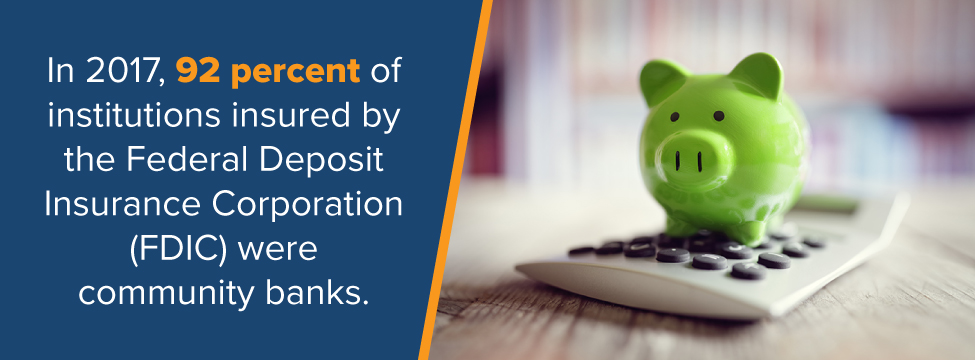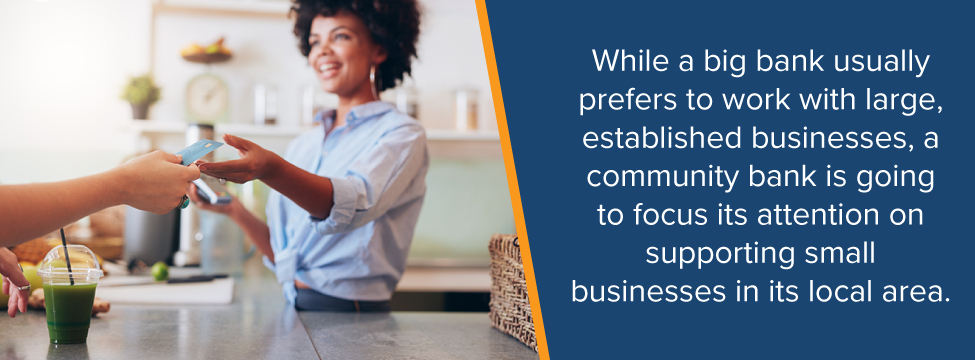Four Advantages of Banking with a Community Bank

Whether you are looking for a loan or for a place to save your money, you have options. You can borrow from or deposit your money at a large financial institution with branches available nationwide. Alternatively, you can open an account at a smaller, community bank.
In 2017, 92 percent of institutions insured by the Federal Deposit Insurance Corporation (FDIC) were community banks. Across the U.S., there are more than 52,000 community bank locations.
While larger banks might seem to offer more bells and whistles than smaller institutions, it often pays to go local when it comes to your money. Here’s why.
Community Bank vs. Big Bank: What’s the Difference?
One of the biggest differences between a community bank and a “big” bank is the number of assets the bank owns. Generally speaking, the majority of community banks have less than $1 billion in total assets, with the average community bank having around $200 million in assets.
Large banks, on the other hand, tend to have more assets. Two of the biggest banks have as much in total assets as all, community banks combined.
But assets are just one of many ways to measure the difference between big banks and local, community banks. Another big difference between a big bank and a community bank is the type of clientele each one serves.
Big banks have more assets than local banks, but they don’t have a lock on the largest number of customers. Community banks are responsible for more than half of all small business loans in the U.S. They also make more than 80 percent of all agricultural loans.
Depending on where you live, a community bank might be your only option when it comes to financial institutions. About 20 percent of counties in the U.S. only have a community bank. In more than 600 counties across the country, there are no big bank branches.

Better Customer Service
Community banks tend to provide better customer service compared to big, national banks. The American Customer Satisfaction Index Finance and Insurance Report for 2016 revealed that community banks had the highest ranking when it came to customer satisfaction, at 83 percent. National banks had the lowest levels of customer satisfaction, at 77 percent.
The report found that people were more likely to rank community banks higher in several areas. For example, community banks scored the highest in categories for teller or staff courtesy and helpfulness, with a 91, and speed of financial transaction, with an 88. Customers also gave community banks scores that exceeded 80 in categories like website satisfaction, call center satisfaction and ease of adding or changing accounts.
Often, when you work with a community bank, you get the sense that you are part of a family. Any services a local bank offers typically come directly from the bank, rather than being outsourced to an outside company. That means you are more likely to see the same tellers at the bank year after year. If you have a loan officer or an investment officer, you are likely to work with the same person for years on end.
Lower rates of turnover and a more hands-on approach to finances are other advantages of community banks and allow them to form deep, long-lasting relationships with their customers. You’re less likely to feel like an account number and more likely to feel like a valued customer when you bank with a local bank.

They Help Build Community
Typically, local banks focus on assisting and building up their local community. While a big bank usually prefers to work with large, established businesses and might have policies that favor individuals who can make hefty deposits, a community bank is going to focus its attention on supporting small businesses in its local area. Across the U.S., community banks lent more than $3.5 billion to small businesses in 2010.
Community banks often put focus on supporting small, local companies and residents because they have close ties to the areas they serve. Community banks are often small businesses themselves, so they understand the challenges many local business owners face — and might have even faced some of the same problems or concerns.
People in the upper levels of management at a local bank, or those on its board of directors, are connected to their local area. They might live and work in the same town that the community bank is based in, play golf or tennis with local business owners or send their kids to school with their customers’ children. When the people at the top of the bank are part of the local community, they are more likely to do what it takes to benefit the community.
Since a local bank is more invested in the community, you might find that it offers more resources or has more ways to help you out than a faceless, big, national bank.
For example, your local bank might give back to the community by encouraging its employees to volunteer during local charitable events or at local non-profits. Some banks donate a portion of their profits to local organizations or non-profits. Many community banks offer scholarships for area high school students as well.

Community Banks Offer a Full Range of Services
It’s often assumed that a community bank is unable to offer the full range of services available at a national, big bank. That’s usually not the case, though. Many local banks offer the same features and services as big banks. Plus, they typically provide those services at a much better rate, as noted above.
Here’s a quick look at some of the services you are likely to find at your local bank:
Personal or Individual Services
- Savings accounts
- Checking accounts
- Individual retirement accounts (IRAs)
- Certificates of deposit
- Money market accounts
- Vacation club accounts for saving for specific, short-term goals
- Mortgages, including jumbo loans, FHA and VA loans
- Home equity lines of credit or loans
- Personal loans or lines of credit
- Credit cards
- Debit cards
- Investment services
- Wealth management
- Trust services
Business Services
- Business credit cards
- Business debit cards
- Business checking accounts
- Money market accounts
- Certificates of Deposits and Certificate of Deposit Account Registry Services
- Nonprofit or government checking accounts
- Commercial loans and lines of credit
- Commercial real estate and construction loans
- Agricultural loans
- SBA loans
- Cash management services
- Business fraud protection
- Escrow accounts
- Sweep accounts
Learn more about the four types of bank accounts and their differences.
Your local community bank doesn’t only provide you with a full suite of products. It also offers you plenty of service options for managing your accounts. By 2013, 61 percent of all internet users said that they did some form of banking online. The good news is that many local banks offer some form of online banking, allowing you to check your deposit amounts, transfer funds and pay bills.

As more and more people use mobile devices to complete tasks that they previously performed on a laptop or desktop, it’s important for community banks to make the move to mobile. By the end of 2014, more than 80 percent of banks offered a mobile app. In March 2016, 53 percent of smartphone users who had bank accounts used mobile banking at some point in the previous 12 months.
What you can do using your bank’s mobile apps varies based on the bank. The most popular services among smartphone users include checking an account balance and transferring money between accounts. Other services offered by mobile apps from a community bank can include mobile deposit, bill payment and person to person transfers.
Additionally, your local bank might have online tools or information to help you make sense of your finances. For example, your bank might have a series of videos that provide an overview or in-depth look at certain financial topics. Other tools your community bank might offer include calculators to help you see how much you can afford to spend on a house, or when you’ll reach certain financial goals.
Community Banks are Focused on the Average Person
Fewer big banks might be in the U.S., but those banks have the greatest number of assets. That’s because they typically concentrate their efforts on wooing and winning over big businesses as customers or prefer to work with individuals who have a high net worth.
Because their typical customer is usually an average person or a small business, community banks tend to be more flexible when it comes to lending. You may be more likely to get a loan from your local bank, with a better rate and terms, than from a big bank, even if you don’t have excellent credit.
That’s because your local bank is more likely to look at you as an entire person, rather than just a credit score. A community bank might look at your family history or your character, as well as your spending habits when deciding on a loan. You’ll be more likely to get a loan from a bank that’s known you as a person for years than you would from a big bank with little or no connection to you or your community.
Another way that community banks tend to focus on the average person rather than those with lots of wealth is that they are more likely to offer accounts with no minimum balance requirements. You’re able to open an account with a local bank with just a few dollars. If you’re having a tough time financially, you don’t have to worry about “parking” a certain amount in your savings account to keep it open or to avoid fees.
Find a Local Bank
It shouldn’t be too difficult to find a community or local bank since there are more than 50,000 of them across the U.S. If you’re in Central Pennsylvania and you’re looking for a local bank for all your financial needs, contact Mid Penn Bank. We offer savings and checking accounts, wealth management services, mortgages and loans and services for small businesses. Get in touch today and see the community bank difference for yourself.
Share:
Disclosures
The material on this site was created for educational purposes. It is not intended to be and should not be treated as legal, tax, investment, accounting, or other professional advice.
Securities and Insurance Products:
NOT A DEPOSIT | NOT FDIC INSURED | NOT BANK GUARANTEED | NOT INSURED BY ANY FEDERAL GOVERNMENT AGENCY | MAY LOSE VALUE
